Modeling Spatial Distribution of Some Contamination within the Lower Reaches of Diyala River Using IDW Interpolation
Abstract
:1. Introduction
2. Study Area
3. Source of Pollution
- (1)
- Five outfalls were recorded as main multi-point sources of pollutants, which disposed the untreated wastewater continuously to the Diyala River and, thus, into the Tigris River. These outfalls were located at different positions along the lower reach of the Diyala River (Figure 1). The Rustimiyah wastewater treatment plant (WWTP) is the oldest project and located on the right bank of Diyala River; 14 km prior to the confluence of the Tigris River, south of Baghdad City. It consists of an old project, and other extensions: the first extension (Ro1), second extension (Ro2), and third extension (R3A); and a new project, dubbed the third expansion (R3B). This project was close to what was known as Army canal outfall. These outfalls caused physical, chemical, and biological pollution, leading to the downstream part of the river.
- (2)
- An unacceptable decrease of water flows of the river in the Baghdad area during dry months due to the construction of two large storage reservoirs in the upper reach of the river.
- (3)
- Returned irrigation water from agricultural areas within the Diyala basin.
- (4)
- Discharge of untreated wastewater from houses, factories, and various institutions directly into the river.
- (5)
- Leakage from sewer pipes and the drinking water distribution network. The efficiency of the water distribution network is about 32% of the production of wastewater [15].
- (6)
- The river was exposed to non-point sources of pollution from agricultural activities and rain that cannot be easily determined
4. River Sampling and Analysis
5. Methodology
Concept of Inverse Distance Weighted (IDW) Interpolation Method
6. Results and Discussion
7. Evaluation of the Performance of the Model
8. Conclusions
- (1)
- The concentration levels of all pollution indicators, T.D.S, T.S.S, Fe, Cu, Cr, and Mn, were within the allowable limits. Then, the concentrations exceeded the allowable limits when wastewater was discharged into the river.
- (2)
- Diyala River’s water affected the quality of the water of the Tigris River where concentrations of some variables exceeded the allowable limits.
- (3)
- Army Canal and Rustimiyah wastewater treatment plant outfall were the greatest significant point sources of contamination that badly affected the water quality of the river. This indicated that the water of the Diyala River within the study reach was not fit for potable water supply and the protection of aquaculture life.
- (4)
- The GIS model can be used as an effective tool to predicting and monitoring water quality. It can reduce the number of monitoring stations by 50%, thus decreasing the effort, and the financial and material costs.
Acknowledgments
Author Contributions
Conflicts of Interest
References
- Chapman, D. Water Quality Assessment, 2nd ed.; E&FN Spon (An Imprint of Chapman & Hall): Cambridge, UK, 1996; p. 585. ISBN 0 419 21590 5 (HB) 0 419 21600 6 (PB). [Google Scholar]
- Yang, M.D.; Merry, C.J.; Sykes, R.M. Adaptive Short-Term Water Quality Forecasts Using Remote Sensing and GIS. Ph.D. Dissertation, Ohio State University, Columbus, OH, USA, 1996. [Google Scholar]
- Vijay, P. Computer Models of Watershed Hydrology, 1st ed.; Water Resources Publications: Littleton, CO, USA, 1995; p. 481. ISBN 2-88074-292-7. [Google Scholar]
- Chabuk, A.; Al-Ansari, N.; Hussain, H.M.; Knutsson, S.; Pusch, R.; Laue, J. Combining GIS Applications and Method of Multi-Criteria Decision-Making (AHP) for Landfill Siting in Al-Hashimiyah Qadhaa, Babylon, Iraq. Sustainability 2017, 9, 1932. [Google Scholar] [CrossRef]
- Panwar, A.; Bartwal, S.; Dangwal, S.; Aswal, A.; Bhandari, A.; Rawat, S. Water Quality Assessment of River Ganga using Remote Sensing and GIS Technique. Int. J. Adv. Remote Sens. GIS 2015, 4, 1253. [Google Scholar] [CrossRef]
- Yan, C.A.; Zhang, W.; Zhang, Z.; Liu, Y.; Deng, C.; Nie, N. Assessment of water quality and identification of polluted risky regions based on field observations & GIS in the honghe river watershed. PLoS ONE 2015, 10, e0119130. [Google Scholar] [CrossRef]
- Oguchi, T.; Jarvie, H.P.; Neal, C. River water quality in the Humber catchment: An introduction using GIS-based mapping and analysis. Sci. Total Environ. 2000, 251, 9–26. [Google Scholar] [CrossRef]
- Usali, N.; Ismail, M.H. Use of remote sensing and GIS in monitoring water quality. J. Sustain. Dev. 2010, 3, 228. [Google Scholar] [CrossRef]
- Li, H.; Li, Y.; Lee, M.-K.; Liu, Z.; Miao, C. Spatiotemporal Analysis of Heavy Metal Water Pollution in Transitional China. Sustainability 2015, 7, 9067–9087. [Google Scholar] [CrossRef]
- Al-Ansari, N.A.; Sayfy, A.; Al-Sinawi, G.T.; Ovanessian, A.A. Evaluation of the water quality for the lower reaches of River Tigris using multivariate analysis. Water Resour. 1986, 5, 1731–1787. [Google Scholar]
- Al-Ansari, N.A.; Al-Sinawi, G.T.; Jamil, A. Suspended and Solute Loads on the Low Diyala River; IAHS-AISH Publication: Wallingford, UK, 1986; Volume 159, pp. 225–235. [Google Scholar]
- Al-Ansari, N. Management of water resources in Iraq: Perspectives and prognoses. Engineering 2013, 5, 6676–6684. [Google Scholar] [CrossRef]
- Al-Jiboury, T.H. Hydrology and Geomorphology of Diyala River. Ph.D. Thesis, Univesity of Baghdad, Baghdad, Iraq, 1991; p. 238. [Google Scholar]
- Abbas, N.; Wasimi, S.; Al-Ansari, N. Impacts of Climate Change on Water Resources in Diyala River Basin, Iraq: Impacts of Climate Change on Water Resources in Diyala River Basin, Iraq. J. Civ. Eng. Archit. 2016, 10, 1059–1074. [Google Scholar] [CrossRef]
- World Bank. Iraq—Country Water Resource Assistance Strategy: Addressing Major Threats to People’s Livelihoods; World Bank: Washington, DC, USA, 2006; Available online: http://documents.worldbank.org/curated/en/944501468253199270/Iraq-Country-water-resource-assi (accessed on 21 December 2017).
- Kubba, F.A.; Joodi, A.S.; Al-Sudani, H.A. Two Dimensional Mathematical Model of Contamination Distribution in the Lower Reach of Diyala River. Master’s Thesis, Al-Mustansiriyah University, Baghdad, Iraq, 2014. [Google Scholar]
- O’sullivan, D.; Unwin, D. Geographic Information Analysis, 2nd ed.; John Wiley & Sons: Hoboken, NJ, USA, 2014; p. 432. ISBN 9780-0-470-28857-3. [Google Scholar]
- Hough, R.L.; Breward, N.; Young, S.D.; Crout, N.M.; Tye, A.M.; Moir, A.M.; Thornton, I. Assessing potential risk of heavy metal exposure from consumption of home-produced vegetables by urban populations. Environ. Health Perspect. 2004, 112, 215–221. [Google Scholar] [CrossRef] [PubMed]
- Anku, Y.S.; Banoeng, B.; Asiedu, D.K.; Yidana, S.M. Water quality analysis of groundwater in crystalline basement rocks Northern Ghana. Environ. Geol. 2009, 58, 989–997. [Google Scholar] [CrossRef]
- Youse, F.D. The Orontes Water Pollution Patterning—Syria—By Means of Geographic Information System GIS. J. Res. Sci. Stud. Eng. 2009, 31, 139–159. [Google Scholar]
- Watson, D.F.; Philip, G.M. A refinement of inverse distance weighted Interpolation. Geo-Processing 1985, 2, 315–327. [Google Scholar]
- George, Y.; David, W. An adaptive inverse-distance weighting spatial interpolation technique. Comput. Geosci. 2008, 34, 1044–1055. [Google Scholar]
- Iraqi Ministry of Education. Data of the Directorate General, Internal Reports; The Department of Scientific Affairs: Baghdad, Iraqi, 2015.
- Iraqi Ministry of Water Resources. State Commission of Survey, Internal Reports; Iraqi Ministry of Water Resources: Baghdad, Iraqi, 1990.
- Iraqi Ministry of Planning. Central Organization for Standardization and Quality Control Iraqi Standard for Drinking Water No. 2270/14. Available online: http://cosqc.gov.iq/ar/home.aspx (accessed on 21 December 2017).
- World Health Organization (WHO). Report of the WHO/UNICEF Joint Monitoring Programme: Progress on Sanitation and Drinking Water. 2017. Available online: http://www.who.int/mediacentre/news/releases/2017/launch-version-report-jmp-water-sanitation-hygiene.pdf?ua=1 (accessed on 21 December 2017).
- Ji, Z.G. Hydrodynamics and Water Quality: Modeling Rivers, Lakes, and Estuaries, 2nd ed.; John Wiley & Sons: Hoboken, NJ, USA, 2017; p. 612. ISBN 9780-0-470-13543-3. [Google Scholar]
- Lindell, T.; Pierson, D.; Premazzi, G. Manual for Monitoring European Lakes Using Remote Sensing Techniques; Joint Research Centre: Ispra, Italy, 1999. [Google Scholar]
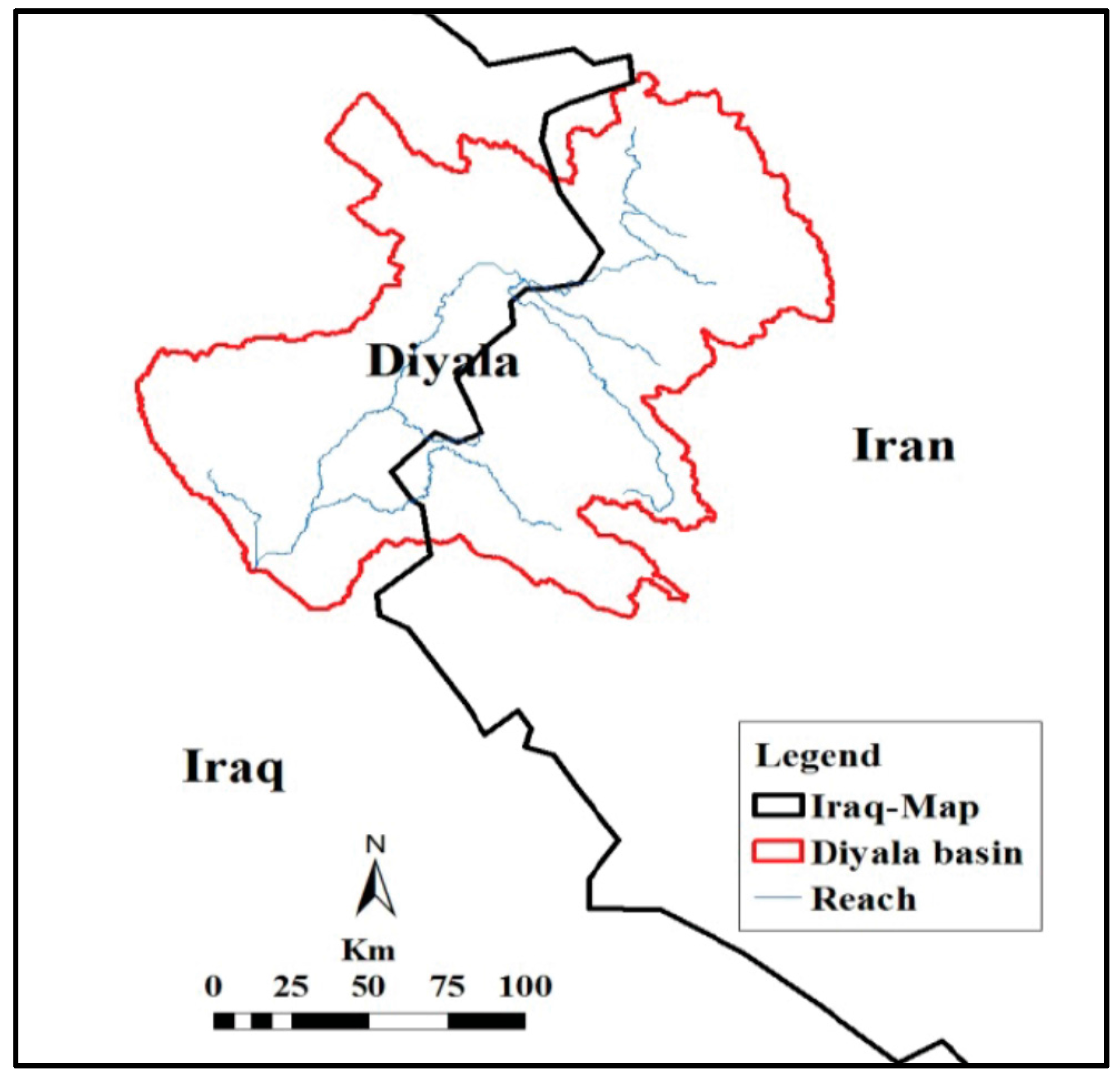
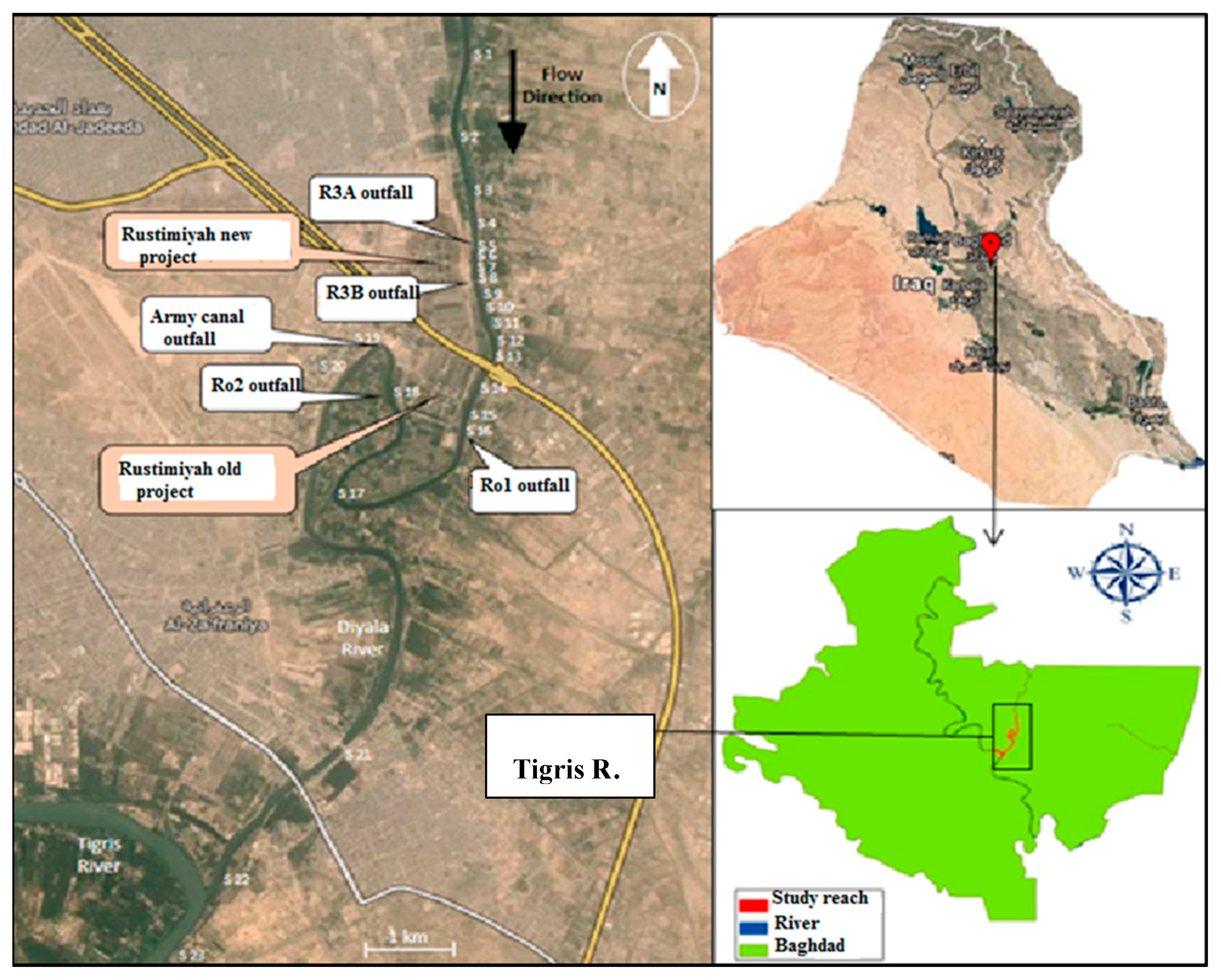
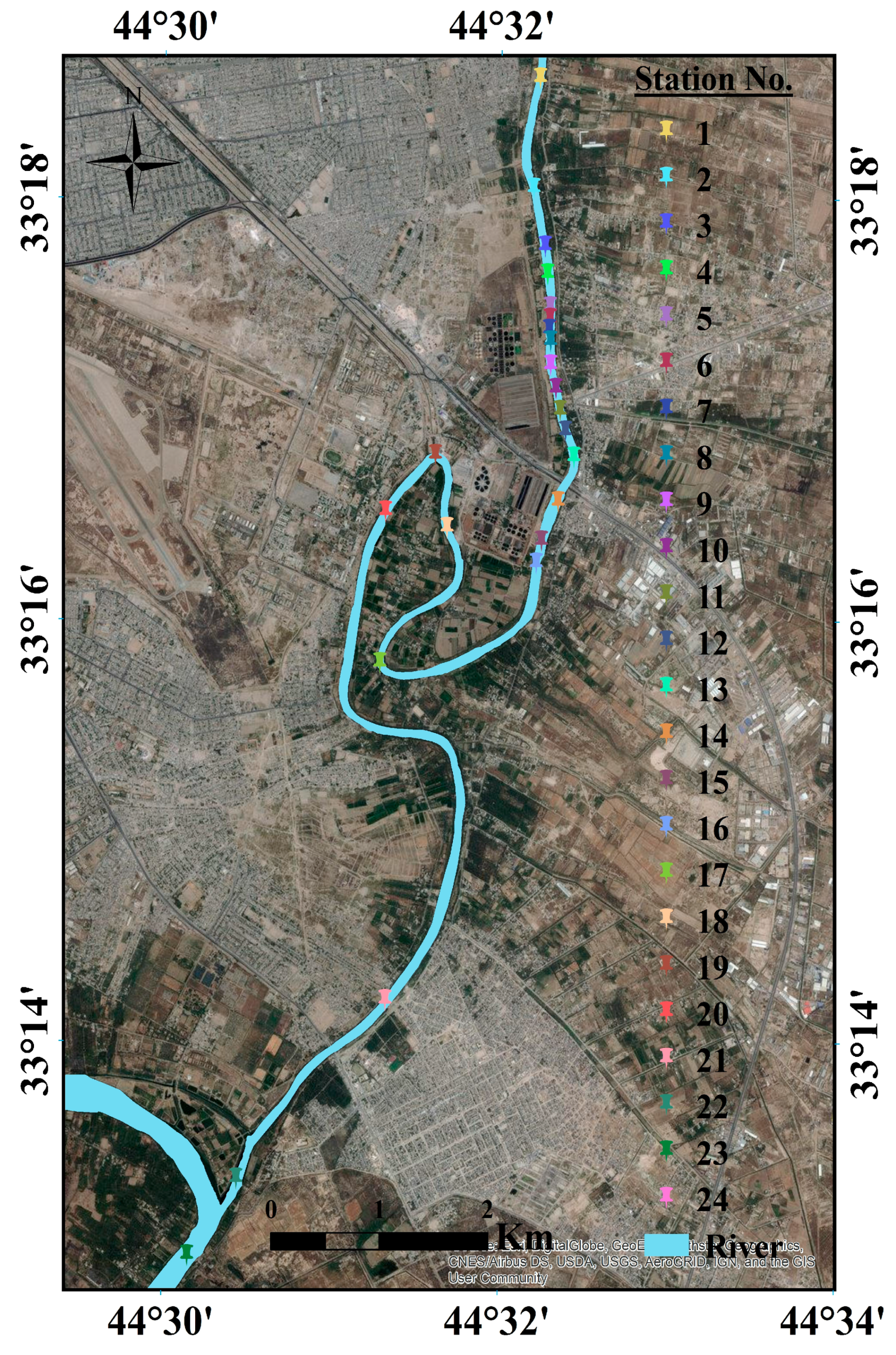

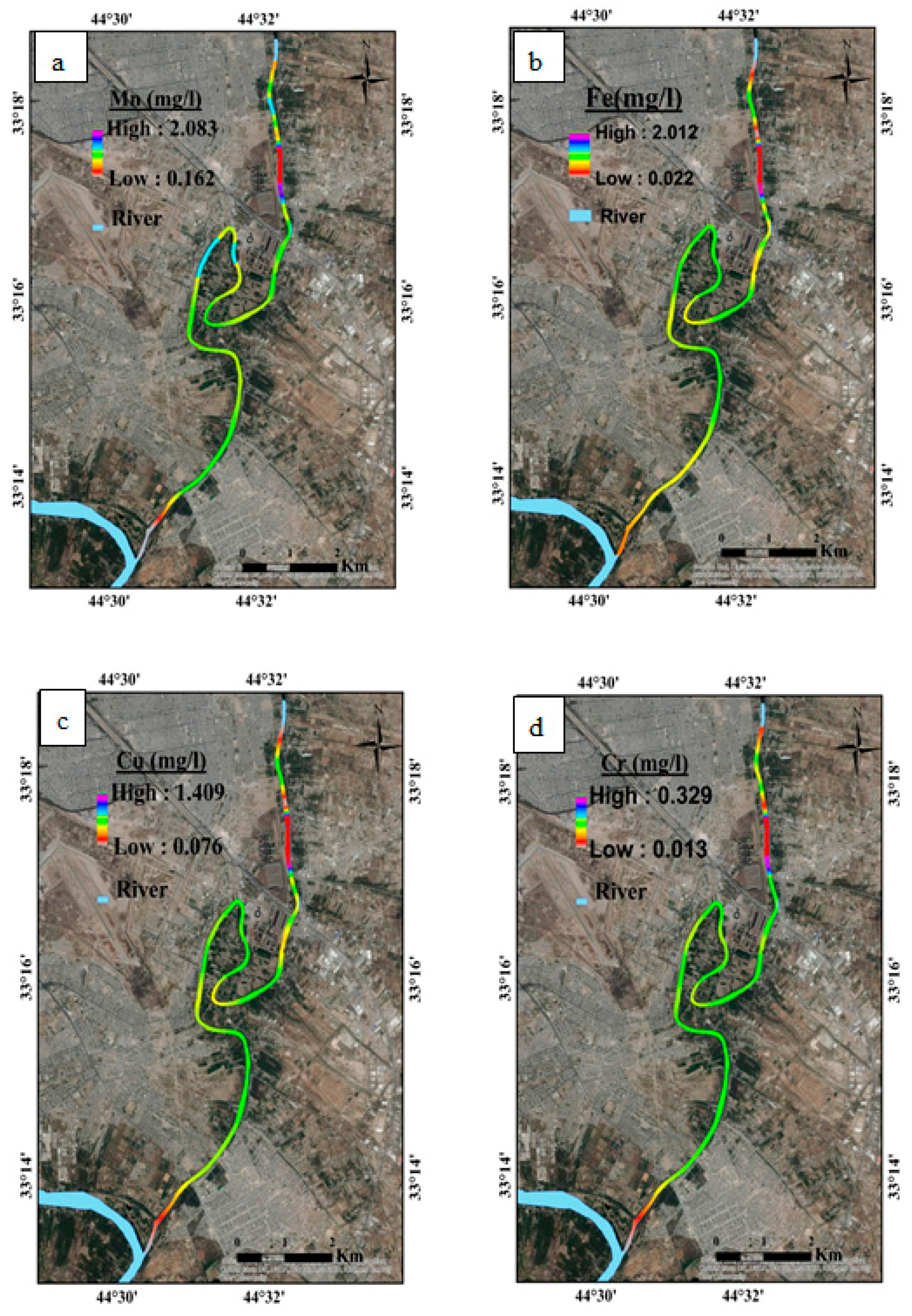
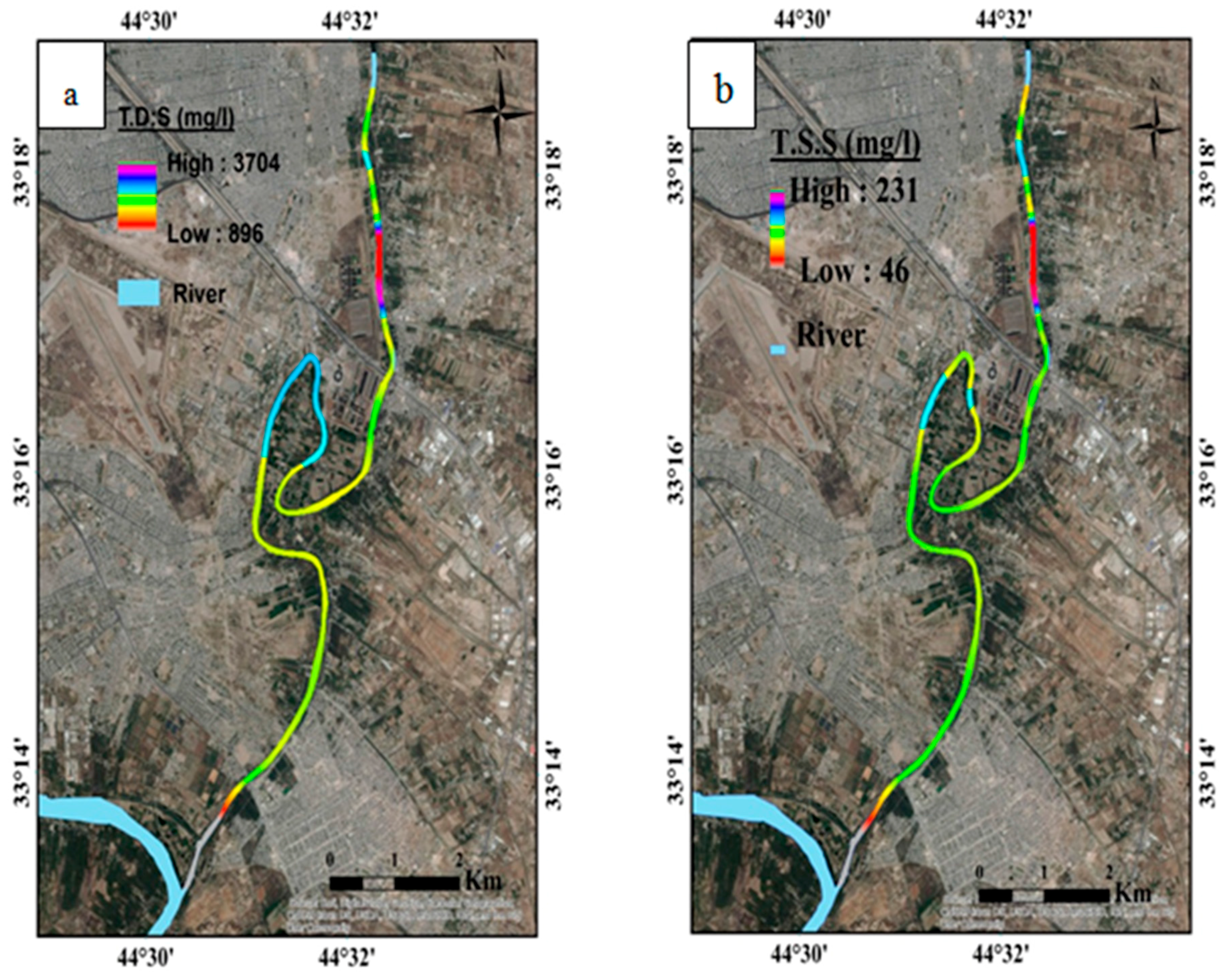
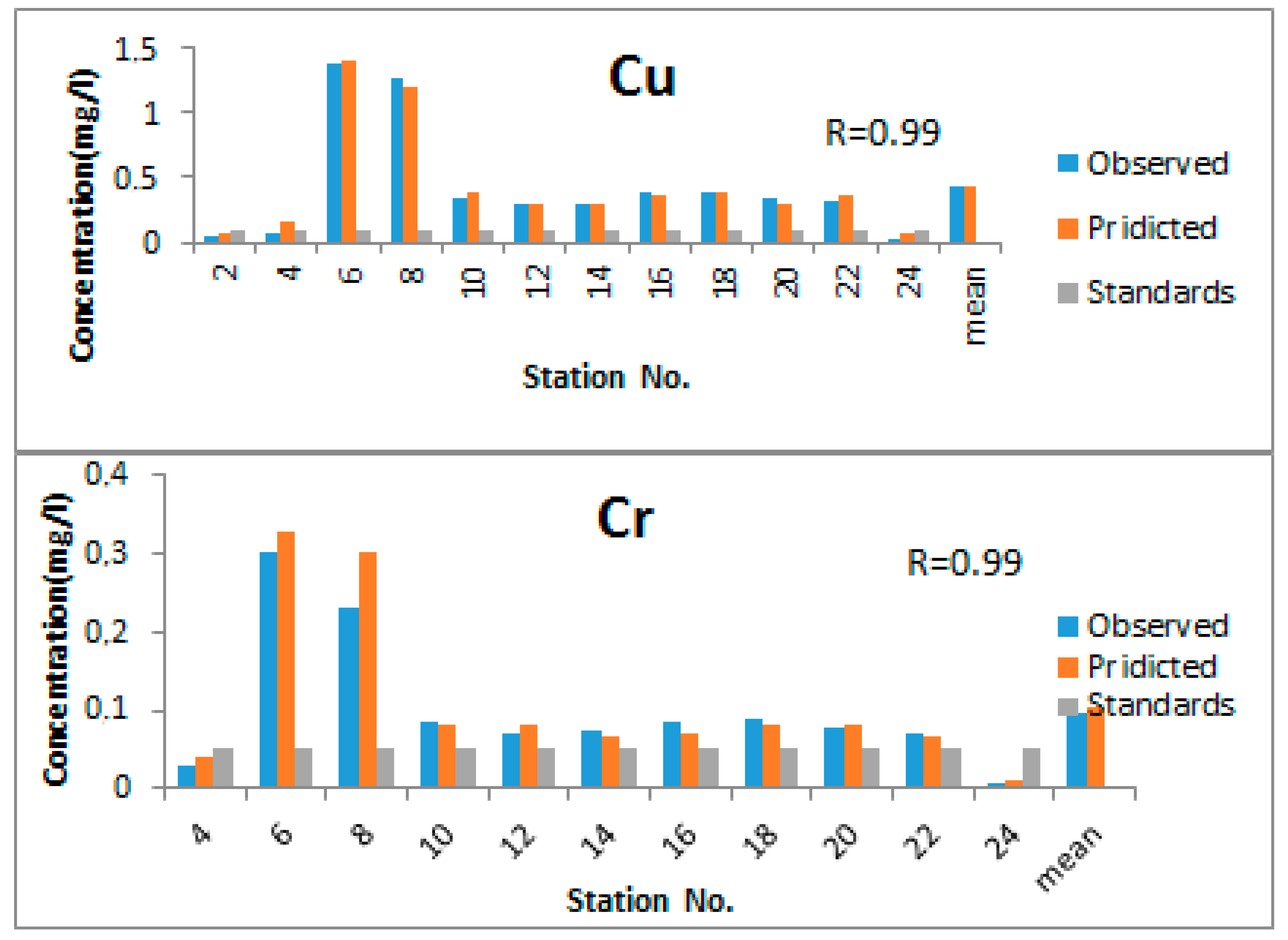
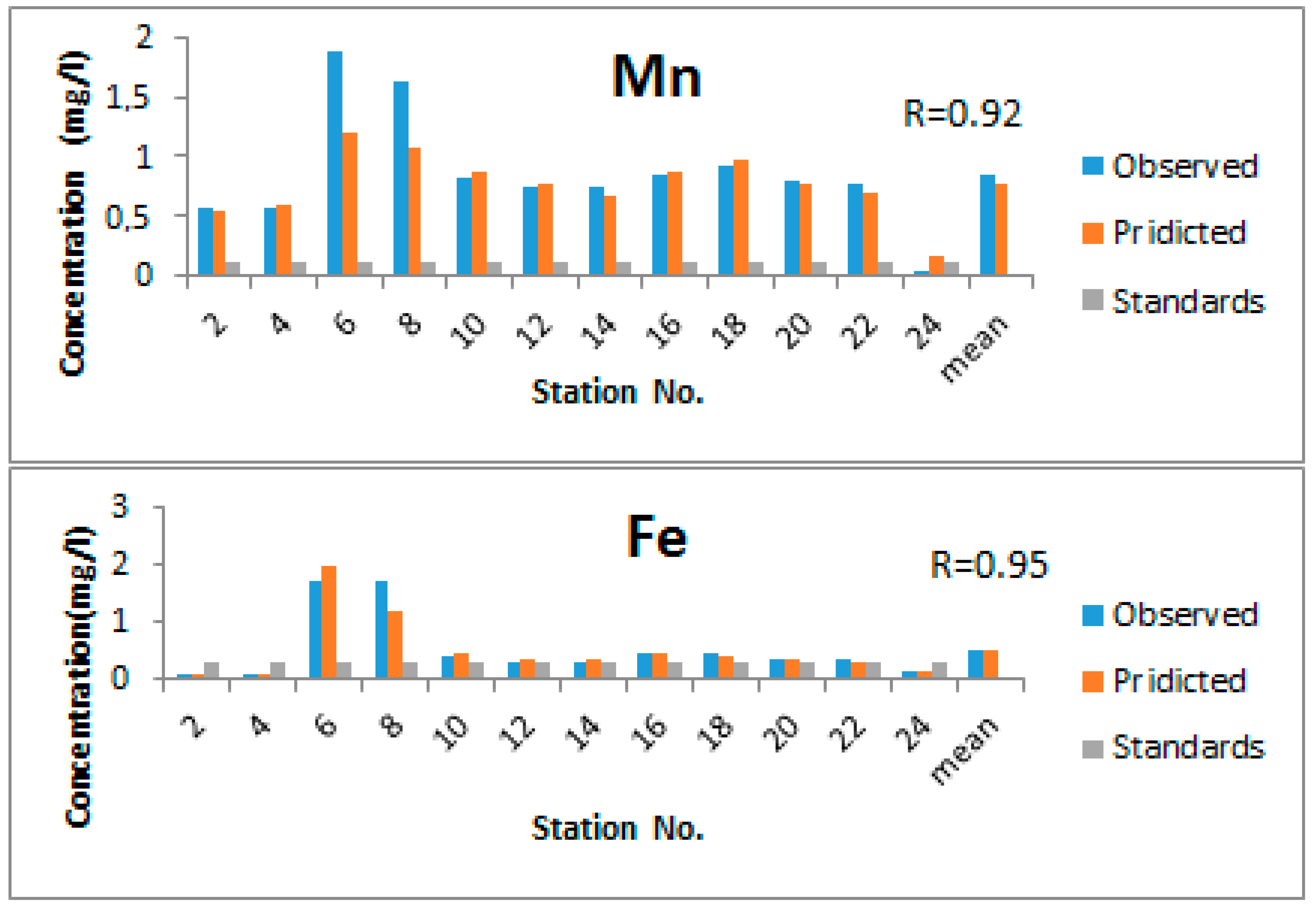
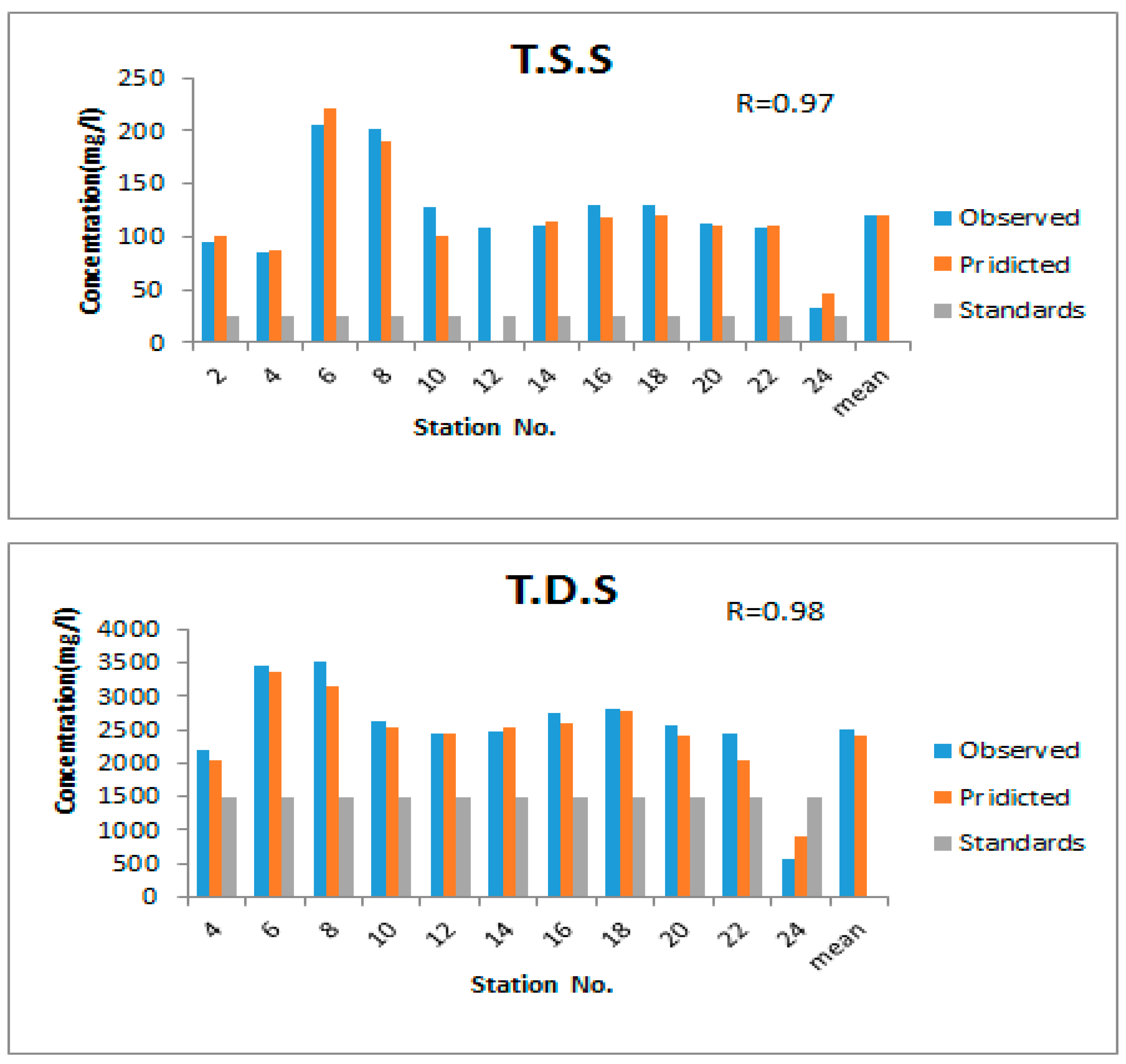
| St. No. | Distance (km) | T.D.S (mg/L) | T.S.S (mg/L) | Fe (mg/L) | Cu (mg/L) | Cr (mg/L) | Mn (mg/L) |
|---|---|---|---|---|---|---|---|
| 1 | 0.0 | 2265 ± 640 | 93 ± 47 | 0.022 ± 0.58 | 0.076 ± 0.42 | 0.033 ± 0.16 | 0.54 ± 0.48 |
| 2 | 1 | 2249 ± 657 | 95 ± 49 | 0.02 ± 0.48 | 0.037 ± 0.49 | 0.034 ± 0.12 | 0.57 ± 0.42 |
| 3 | 1.5 | 2270 ± 669 | 96 ± 45 | 0.023 ± 0.34 | 0.082 ± 0.38 | 0.031 ± 0.18 | 0.57 ± 0.4 |
| 4 | 1.75 | 2188 ± 537 | 86 ± 43 | 0.026 ± 0.51 | 0.075 ± 0.26 | 0.031 ± 0.19 | 0.55 ± 0.44 |
| 5 | 2 | 3705 ± 690 | 231 ± 20 | 2.013 ± 0.45 | 1.41 ± 0.19 | 0.329 ± 0.15 | 2.09 ± 0.41 |
| 6 | 2.1 | 3453 ± 636 | 205 ± 43 | 1.742 ± 0.23 | 1.381 ± 0.28 | 0.3 ± 0.19 | 1.88 ± 0.42 |
| 7 | 2.2 | 3371 ± 603 | 212 ± 41 | 1.659 ± 0.33 | 1.221 ± 0.38 | 0.259 ± 0.12 | 1.7 ± 0.48 |
| 8 | 2.3 | 3518 ± 639 | 202 ± 48 | 1.734 ± 0.35 | 1.261 ± 0.29 | 0.232 ± 0.12 | 1.6 ± 0.31 |
| 9 | 2.5 | 3183 ± 608 | 163 ± 49 | 0.914 ± 0.38 | 0.745 ± 0.49 | 0.147 ± 0.17 | 1.1 ± 0.29 |
| 10 | 2.7 | 2641 ± 589 | 127 ± 43 | 0.403 ± 0.18 | 0.332 ± 0.46 | 0.086 ± 0.13 | 0.81 ± 0.36 |
| 11 | 2.9 | 2539 ± 522 | 112 ± 48 | 0.348 ± .29 | 0.31 ± 0.29 | 0.079 ± 0.16 | 0.82 ± 0.48 |
| 12 | 3.1 | 2451 ± 591 | 110 ± 42 | 0.308 ± .39 | 0.293 ± 0.36 | 0.07 ± 0.19 | 0.74 ± 0.41 |
| 13 | 3.3 | 2526 ± 593 | 105 ± 39 | 0.314 ± 0.26 | 0.288 ± 0.19 | 0.075 ± 0.19 | 0.75 ± 0.4 |
| 14 | 3.7 | 2467 ± 501 | 129 ± 42 | 0.3 ± 0.29 | 0.303 ± 0.38 | 0.076 ± 0.14 | 0.73 ± 0.32 |
| 15 | 4.1 | 2446 ± 493 | 113 ± 35 | 0.291 ± 0.19 | 0.266 ± 0.41 | 0.071 ± 0.17 | 0.7 ± 0.25 |
| 16 | 4.3 | 2760 ± 496 | 110 ± 20 | 0.454 ± 0.28 | 0.392 ± 0.22 | 0.085 ± 0.16 | 0.84 ± 0.28 |
| 17 | 6 | 2547 ± 499 | 105 ± 48 | 0.335 ± 0.37 | 0.301 ± 0.32 | 0.07 ± 0.08 | 0.79 ± 0.27 |
| 18 | 7.5 | 2813 ± 477 | 129 ± 28 | 0.427 ± 0.46 | 0.397 ± 0.25 | 0.09 ± 0.02 | 0.91 ± 0.21 |
| 19 | 8.2 | 2725 ± 434 | 117 ± 23 | 0.409 ± 0.51 | 0.375 ± 0.16 | 0.08 ± 0.06 | 0.83 ± 0.19 |
| 20 | 8.8 | 2571 ± 482 | 113 ± 40 | 0.351 ± 0.26 | 0.344 ± 0.24 | 0.08 ± 0.02 | 0.79 ± 0.15 |
| 21 | 13.5 | 2572 ± 423 | 115 ± 35 | 0.349 ± 0.34 | 0.337 ± 0.31 | 0.08 ± 0.04 | 0.788 ± 0.2 |
| 22 | 15.3 | 2454 ± 553 | 108 ± 29 | 0.342 ± 0.26 | 0.32 ± 0.22 | 0.07 ± 0.02 | 0.756 ± 0.2 |
| 23 | 16 | 896 ± 491 | 46 ± 20 | 0.192 ± 0.23 | 0.076 ± 0.14 | 0.01 ± 0.04 | 0.161 ± 0.18 |
| 24 | 17 | 560 ± 412 | 33 ± 21 | 0.11 ± 0.24 | 0.023 ± 0.12 | 0 | 0.02 ± 0.2 |
| Variable | Max. Concentration (mg/L) | Location | Min. Concentration (mg/L) | Location |
|---|---|---|---|---|
| Cr | 0.329 | Station 5 | 0.013 | Station 24 |
| Fe | 2.012 | Station 5 | 0.022 | Station 24 |
| Cu | 1.409 | Station 5 | 0.076 | Station 24 |
| Mn | 2.083 | Station 5 | 0.162 | Station 24 |
| T.D.S | 3704 | Station 5 | 896 | Station 24 |
| T.S.S | 231 | Station 5 | 46 | Station 24 |
| Variable | Symbol | Upper Limit IRAQI (mg/L) | Upper Limit WHO (mg/L) |
|---|---|---|---|
| Total Dissolved Solids | T.D.S | 1500 | 1200 |
| Total Suspended Solids | T.S.S | 25 | 30 |
| Copper | Cu | 0.1 | 1.0 |
| Chromium | Cr | 0.05 | 0.05 |
| Manganese | Mn | 0.05 | 0.05 |
| Iron | Fe | 0.3 | 0.3 |
© 2017 by the authors. Licensee MDPI, Basel, Switzerland. This article is an open access article distributed under the terms and conditions of the Creative Commons Attribution (CC BY) license (http://creativecommons.org/licenses/by/4.0/).
Share and Cite
Madhloom, H.M.; Al-Ansari, N.; Laue, J.; Chabuk, A. Modeling Spatial Distribution of Some Contamination within the Lower Reaches of Diyala River Using IDW Interpolation. Sustainability 2018, 10, 22. https://doi.org/10.3390/su10010022
Madhloom HM, Al-Ansari N, Laue J, Chabuk A. Modeling Spatial Distribution of Some Contamination within the Lower Reaches of Diyala River Using IDW Interpolation. Sustainability. 2018; 10(1):22. https://doi.org/10.3390/su10010022
Chicago/Turabian StyleMadhloom, Huda M., Nadhir Al-Ansari, Jan Laue, and Ali Chabuk. 2018. "Modeling Spatial Distribution of Some Contamination within the Lower Reaches of Diyala River Using IDW Interpolation" Sustainability 10, no. 1: 22. https://doi.org/10.3390/su10010022






